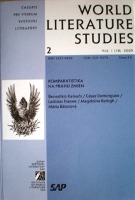Poznámky k ideovo-historickému kontextu pojmu „ľudovosť“ v stredoeurópskom socialistickom realizme
NOTES ON THE CULTURAL AND IDEOLOGICAL CONTEXT OF THE IDEA OF “NÉPISÉG” (POPULISM) IN THE DOCTRINE OF CENTRAL-EUROPEAN SOC-REALISM
Author(s): Magdolna BaloghSubject(s): Literary Texts
Published by: SAV - Slovenská akadémia vied - Ústav svetovej literatúry
Keywords: Soc-Realism; Central Europe; Hungary; Populism; Volksgeist; Ideology
Summary/Abstract: The aim of the study is to describe and to examine the notion of “népiség” (populism, “Volkheit”), which was one of the central conceptions of soc-realism and the major political requirement of the so-called new literature in the Stalinist era as declared by political and cultural leaders. This notion has not been researched thoroughly. The author of the present study, therefore, expresses her own reservations as far as her definition of the term, which eludes a precise definition, is concerned. For example, each Slavic language has only one word to express it (“lidovost”, “ľudovost’”, “narodnost”), but two words, “népiség” and “népiesség”, can be found in Hungarian. “Népiesség” (Volkstümlichkeit, folksiness, traditionalism) describes the “appearance of traditional elements in the elite culture” and it belongs to the authentic folkloristic/ traditional elements of the culture. On the other hand, “népiség” (Volksverbundenheit, “populism”) means “traditionalism” which has turned into a “political ideology” in the “népi” (populist) movement. It is obvious that only the latter can be applied to soc-realism.
Journal: World Literature Studies
- Issue Year: I/2009
- Issue No: 2
- Page Range: 42-57
- Page Count: 16
- Language: Slovak

